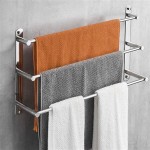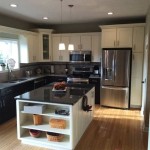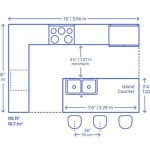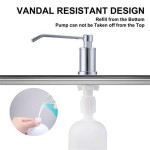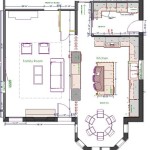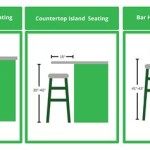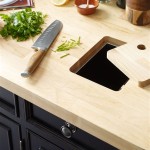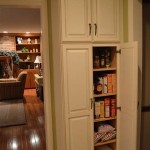Wall-Mounted Bridge Kitchen Faucets: A Blend of Functionality and Style
The kitchen faucet is an essential component of any culinary space, fulfilling the basic function of providing water for food preparation, cleaning, and general use. While numerous faucet styles exist, the wall-mounted bridge kitchen faucet has emerged as a popular choice for homeowners seeking to combine functionality with a distinctive aesthetic. This type of faucet distinguishes itself from deck-mounted options by being installed directly onto the wall behind the sink, creating a clean, uncluttered countertop and offering a unique visual appeal.
A bridge faucet, by definition, incorporates two separate handles – one for hot water and one for cold – connected by a horizontal pipe, referred to as the "bridge." This design allows for precise temperature control and adds a touch of classic elegance to modern and traditional kitchens alike. When mounted on the wall, the bridge faucet further enhances the kitchen's visual appeal and offers practical advantages, making it a worthwhile consideration for kitchen renovations or new constructions.
This article delves into the characteristics, advantages, installation considerations, and design aspects of wall-mounted bridge kitchen faucets, providing a comprehensive overview for individuals considering this style for their kitchen.
Space Optimization and Enhanced Hygiene
One of the key benefits of opting for a wall-mounted bridge kitchen faucet lies in its ability to optimize countertop space. In kitchens where counter space is limited, every inch counts. By eliminating the need for a faucet base and handle assembly on the countertop, these faucets free up valuable area for food preparation, appliance placement, or simply a less cluttered aesthetic. This is particularly advantageous in smaller kitchens or those with unconventional sink configurations.
The wall-mounted design also contributes to enhanced hygiene. With fewer obstructions around the sink, cleaning becomes significantly easier. There are no crevices or hard-to-reach areas around the base of a deck-mounted faucet where food particles and grime can accumulate. A simple wipe down of the countertop is all that is needed to maintain a clean and sanitary workspace. This reduction in potential dirt traps makes wall-mounted bridge faucets a particularly attractive option for those prioritizing cleanliness and ease of maintenance in their kitchen.
Furthermore, the absence of a faucet base eliminates the potential for water damage around the sink. Deck-mounted faucets, even with proper sealing, can sometimes allow water to seep underneath, leading to potential mold growth or damage to the countertop material. Wall-mounted faucets completely remove this risk, providing an added layer of protection for the kitchen's structure.
Aesthetic Versatility and Design Impact
Beyond its practical advantages, the wall-mounted bridge kitchen faucet offers significant aesthetic versatility. These faucets are available in a wide array of styles, finishes, and designs, allowing homeowners to seamlessly integrate them into various kitchen aesthetics, from rustic farmhouse to sleek modern. The "bridge" component itself can be crafted in varying shapes and sizes, further contributing to the faucet's overall visual impact.
Common finishes include polished chrome, brushed nickel, oil-rubbed bronze, and matte black, each offering a distinct visual appeal. Chrome provides a classic, reflective shine, while brushed nickel offers a more subtle, contemporary look. Oil-rubbed bronze evokes a sense of warmth and tradition, while matte black adds a bold, modern touch. The choice of finish should complement the overall color scheme and hardware of the kitchen to create a cohesive and visually appealing design.
The spout design is another area where aesthetic versatility shines. Options range from traditional gooseneck spouts to more streamlined, minimalist designs. The height and reach of the spout should also be carefully considered to ensure it aligns with the size and depth of the sink. A spout that is too short or too low may lead to splashing, while one that is too long or too high may be awkward to use. Finding the right balance between form and function is essential for achieving optimal aesthetic and practical value.
Wall-mounted bridge faucets can also serve as a focal point in the kitchen, drawing the eye and adding a touch of elegance and sophistication. This is particularly true when paired with a decorative backsplash or a statement sink. The faucet can become a design element in its own right, contributing to the overall character and ambiance of the kitchen.
Installation Considerations and Plumbing Requirements
While wall-mounted bridge kitchen faucets offer numerous advantages, their installation can be more complex than that of deck-mounted faucets. Proper planning and execution are crucial to ensure a successful and leak-free installation. It is often recommended that a qualified plumber be involved in the process, particularly when dealing with existing plumbing lines.
The primary consideration is the location of the water supply lines within the wall. These lines must be positioned at the correct height and width to align with the faucet's connection points. If the existing plumbing is not properly located, modifications may be necessary, which can involve cutting into the wall and rerouting the pipes. This is where the expertise of a plumber becomes invaluable.
The wall structure itself must also be able to adequately support the weight of the faucet and the stress of repeated use. Reinforcement may be required, particularly if the wall is constructed of lightweight materials such as drywall. A solid backing behind the wall where the faucet will be mounted is essential to prevent the faucet from loosening or becoming unstable over time.
Another important consideration is the spacing between the hot and cold water inlets on the faucet. This spacing must be consistent with the spacing of the water supply lines in the wall. Inconsistencies can lead to leaks or damage to the faucet. It is crucial to carefully measure and verify all dimensions before proceeding with the installation.
Finally, it is important to ensure that the faucet is properly sealed against the wall to prevent water from seeping behind it. This can be achieved using plumber's putty or silicone sealant. The sealant should be applied carefully and thoroughly to create a watertight barrier.
In summary, while the installation of a wall-mounted bridge kitchen faucet may require more planning and effort than that of a deck-mounted faucet, the aesthetic and practical benefits can make it a worthwhile investment. By carefully considering the plumbing requirements, wall structure, and sealing procedures, homeowners can ensure a successful and long-lasting installation.
Choosing a wall-mounted bridge kitchen faucet is not simply about selecting a fixture; it is about curating an experience. It’s about acknowledging the kitchen as a space that deserves both functionality and artistry. By understanding the considerations outlined above, homeowners can make informed decisions and create a kitchen that reflects their personal style and meets their specific needs.

Wall Mounted Bridge Kitchen Faucet

Wall Mounted Bridge Kitchen Faucet With Porcelain Lever Handles

Upiker Double Handle Wall Mounted Bridge Kitchen Faucet With Pull Down Sprayer Head In Brushed Nickel Up2304kfbn0024

Upiker Double Handle Wall Mounted Bridge Kitchen Faucet With Pull Down Sprayer Head In Matte Black Up2304kfmb0024

Kingston Brass Wall Mount Bridge Kitchen Faucet Copper Sinks Online

Kingston Brass Ks124 Ax Heritage Wall Mount Bridge Kitchen Faucet Watermarkfixtures

Watermark 206 7 V Paris Wall Mounted Bridge Kitchen Faucet Plumbing Overstock

Wall Mounted Bridge Kitchen Faucet Metal Cross Handles

Concord Gs8281dl Double Handle 2 Hole Wall Mount Pre Rinse Bridge Kitchen Faucet Polished Chrome

Double Handle Wall Mounted Spring Neck Bridge Kitchen Faucet Matte Black Walmart Com

